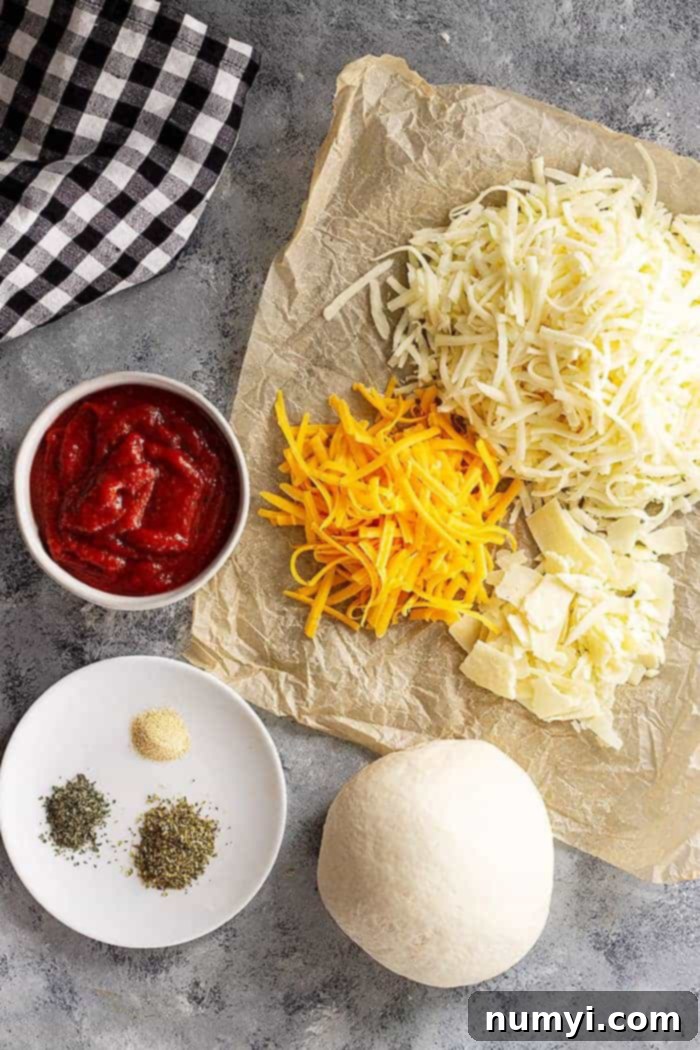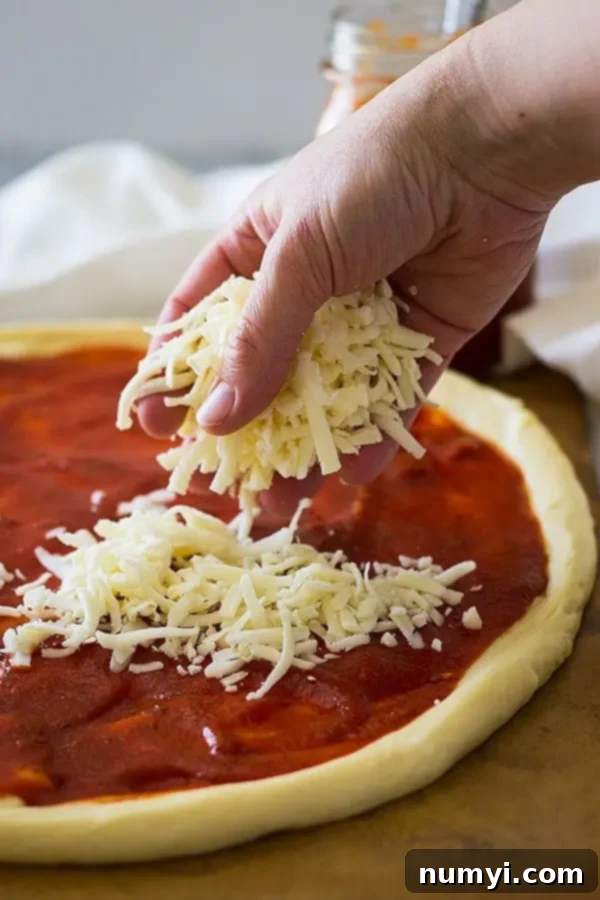Delicious Homemade Three Cheese Pizza: Your Go-To Recipe for a Perfect Pizza Night In
My homemade Cheese Pizza features a soft, chewy crust, a rich, flavorful homemade sauce, and is generously topped with three kinds of irresistible cheeses. It’s truly perfect for a fun and cheesy pizza night “in” with the whole family!

The Ultimate Cheesy Pizza Experience at Home
There’s nothing quite like a homemade pizza, and in my house, “pizza night in” has become a cherished family tradition! This three-cheese pizza recipe is more than just a meal; it’s an experience. The kids absolutely love getting involved, choosing their favorite additional toppings to personalize their slices, but this glorious cheesy base is always the star. Forget the endless wait for takeout or the cost of a restaurant meal; crafting your own delicious pizza is a rewarding, budget-friendly, and incredibly fun activity for everyone.
For the best results, I highly recommend using my Homemade Pizza Dough and Homemade Pizza Sauce. These recipes are designed to complement each other perfectly, ensuring every bite is packed with authentic flavor. However, if you’re short on time, a good quality store-bought sauce will certainly do the trick. And don’t forget to whip up some cheesy breadsticks to go alongside for the ultimate pizza feast!
A good pizza is universally loved, but a good homemade pizza? That’s on a whole other level. This particular cheese pizza recipe is a family favorite and makes a frequent appearance on our dinner table. It’s a guaranteed win-win: incredible taste, less expensive than ordering out, and no waiting around for delivery!
Why You’ll Fall in Love with This Homemade Three Cheese Pizza
Once you try this recipe, you’ll understand why it’s a staple. Here are just a few reasons why this homemade three cheese pizza will become your new go-to:
- Perfect Crust Every Time: Achieves that ideal balance of a slightly crispy exterior and a wonderfully soft, chewy interior. It’s the foundation of a truly great pizza.
- Surprisingly Easy to Make: Don’t be intimidated by homemade pizza! This recipe is straightforward and designed for home cooks of all skill levels.
- Versatile Topping Base: While it’s fantastic on its own, this cheese pizza provides the ultimate canvas for any additional toppings you can dream up, making it perfect for custom creations.
- Flexible Sauce Options: Whether you prefer to make your own from scratch using my homemade pizza sauce recipe or opt for the convenience of store-bought, this recipe is adaptable to your preference.
- Family-Friendly Fun: Getting everyone involved in the pizza-making process, from stretching the dough to adding cheese, creates lasting memories and makes dinner an event.
- Budget-Friendly Meal: Enjoy restaurant-quality pizza without the restaurant price tag. Making pizza at home is significantly more economical.

Essential Ingredients for Your Mozzarella, Parmesan, and Cheddar Cheese Pizza
The magic of this three-cheese pizza lies in the quality of its ingredients, especially the dough and sauce. While you can opt for store-bought, for an truly exceptional homemade experience, I highly recommend utilizing my homemade pizza dough and pizza sauce recipes. You can find all the detailed instructions and tips by clicking on the provided links. Below is a breakdown of what you’ll need and why each component is crucial:
- CHEESE: The star of our show! I use a fantastic trifecta: a generous amount of shredded mozzarella for its classic melty stretch, sharp cheddar cheese for a robust flavor kick, and grated Parmesan for its salty, nutty depth. This combination creates an unparalleled gooey and flavorful experience. Feel free to customize this blend with your personal favorites or omit any you don’t prefer. Other great options include provolone, ricotta, or even a sprinkle of crumbled goat cheese.
- FLOUR: The backbone of a perfect crust. You can use either all-purpose flour or bread flour. I personally lean towards bread flour because its higher protein content develops more gluten, resulting in a delightfully chewier crust, which is exactly what you want in a great pizza. However, all-purpose flour works perfectly well if that’s what you have on hand.
- YEAST: This is what gives your pizza dough its airy, light texture and helps it rise beautifully. Both active dry yeast and instant (or rapid rise) yeast will work for this recipe. If you’re using active dry yeast, simply be aware that the dough might take a little longer to proof or rise, but the end result will be just as delicious. I often use Red Star All Natural Yeast as it contains no added ingredients.
- WATER: Essential for activating the yeast. Ensure your water is warm, ideally between 110-115 degrees F, to properly hydrate and dissolve the yeast, allowing it to begin its work. Water that is too hot can kill the yeast, while water that is too cold won’t activate it effectively. For an even softer crust, you can substitute a portion of the water with milk.
- OIL: Extra virgin olive oil is my preferred choice for the dough. It not only imparts a wonderful, subtle flavor but also helps to keep the dough tender and pliable, making it easier to work with and contributing to a better texture in the final crust.
- SUGAR: Only a small amount is needed, primarily to “feed” the yeast, giving it an initial boost for rising. A tiny pinch in the sauce also helps to balance and cut through the natural acidity of the tomatoes, enhancing the overall flavor profile.
- SALT: A critical ingredient in any yeast-based baking. While sugar nourishes the yeast, salt plays the vital role of regulating its growth, ensuring a steady, controlled rise. This slow and steady proofing contributes significantly to the development of that distinct, complex homemade flavor we all crave.
- TOMATO SAUCE: A good quality canned tomato sauce is perfectly acceptable and forms the base of our flavorful pizza sauce. Look for one with minimal added ingredients for the purest tomato taste.
- TOMATO PASTE: Added to the sauce for an even more concentrated and rich tomato flavor. It deepens the color and enhances the umami notes.
- EXTRA VIRGIN OLIVE OIL (for sauce): A drizzle of good quality EVOO in the sauce can significantly enhance its richness and mouthfeel.
- SEASONINGS: These aromatic herbs and spices elevate the flavor of your pizza sauce and complement the cheeses beautifully. You’ll need dried oregano, dried basil, garlic powder, red pepper flakes (for a touch of heat, optional), and freshly ground black pepper.
Step-by-Step Instructions to Make Your Delicious 3 Cheese Pizza
Making homemade pizza is a fun and rewarding process. Follow these steps to create a cheesy masterpiece:
PREP THE DOUGH AND SAUCE: If you’re taking the homemade route (which I highly recommend!), now is the time to prepare your pizza dough and pizza sauce. Allow the dough to complete its first rise while you prepare the rest of your ingredients.
OVEN AND PAN PREP: Begin by preheating your oven to a robust 425 degrees F (220 degrees C). While the oven heats, lightly grease your chosen pizza pan, baking sheet, or pizza stone. If using a pizza stone, place it in the cold oven as it preheats to ensure it’s piping hot when the pizza goes in. This helps achieve a crispier crust.

FORM THE CRUST: Transfer your prepared pizza dough to a lightly floured surface. Using a rolling pin or, for a more authentic touch, gently stretching with your hands, form the dough into a 14-inch circle. Carefully transfer the dough to your prepared pan. Create a small, raised lip around the edge of the dough; this “crust” will act as a delicious barrier, preventing your yummy toppings from spilling over the sides.

LAYER THE TOPPINGS: Evenly spoon your homemade pizza sauce onto the dough, spreading it across the entire circle but leaving that lovely raised crust edge clear. Next, scatter the shredded mozzarella, cheddar, and Parmesan cheeses generously over the sauce. Finally, sprinkle the dried oregano, basil, and garlic powder over the cheese. A little red pepper flake can be added now if you enjoy a touch of heat.
BAKE TO PERFECTION: Carefully place your mozzarella, Parmesan, and cheddar cheese pizza into the preheated oven. Bake for approximately 15-20 minutes. Keep a close eye on it; you’re looking for the cheese to be completely melted, bubbly, and slightly golden, and the crust to achieve a beautiful golden brown color. Once baked, remove the pizza from the oven and let it cool for a few minutes on a wire rack before slicing. This brief cooling period helps the cheese set and makes for easier, cleaner slices. Then, serve and enjoy your delicious homemade creation!
The Art of Stretching vs. Rolling Pizza Dough
The method you choose for shaping your pizza dough can significantly impact the final texture of your crust. While using a rolling pin is perfectly acceptable and often easier for beginners, gently stretching the dough by hand can yield a more authentic, artisanal crust with a superior texture.
Here are compelling reasons to consider stretching your dough over rolling it:
- Puffier Crust: Stretching the dough by hand is a more delicate process that helps to preserve the tiny air bubbles created during fermentation. These air pockets expand during baking, resulting in a lighter, airier, and significantly puffier crust that is wonderfully tender inside.
- Prevents Dryness: Rolling dough can sometimes compress it too much, forcing out the precious air and moisture. This can lead to a crust that bakes up thin and dry. Hand stretching, on the other hand, allows you to maintain a better balance, preventing the dough from becoming overly dense or thin.
- More Authentic Texture: Many pizzaiolos (pizza makers) swear by hand stretching because it creates an uneven, rustic texture in the crust, complete with delightful pockets of chewiness and crispness that are hard to replicate with a rolling pin.
To stretch by hand, begin by gently pressing the center of the dough outwards with your fingertips, working in a circular motion. Once a small disc forms, lift the dough and carefully drape it over your fists. Let gravity do some of the work, gently pulling and rotating the dough as it stretches. Try to avoid excessively handling the very edges of the dough, as this helps preserve the air that will create that beautiful, puffy “cornicione” (the rim of the crust). Don’t worry if your first few attempts aren’t perfectly round; practice makes perfect, and the taste will still be incredible! For a visual guide, this video on How to Stretch Pizza Dough can be very helpful.
Another common question is whether to prick the dough before topping. This is entirely up to personal preference. Pricking the dough with a fork before adding sauce and toppings can help prevent large, unsightly air bubbles from forming in the center of your pizza during baking, ensuring a flatter, more even surface. However, some people enjoy the occasional larger bubble for textural variety. I sometimes prick, sometimes don’t – both yield delicious results!

Exciting Topping Ideas for Your Next Pizza Night!
Hosting a pizza night with family or friends is a fantastic way to enjoy delicious food and create fun memories. Encourage everyone to get creative and make their own mini pizzas, customizing them with their favorite ingredients. This three cheese pizza recipe serves as an incredible foundation for any additional toppings you desire.
However, I have one crucial rule for pizza topping success: do not overload your pizza(s) with too many toppings! While tempting, excessive toppings can weigh down the crust, prevent it from rising properly, and ultimately lead to a soggy, undercooked pizza. Trust me on this one – I’ve learned from experience! And please, for the love of perfectly cooked toppings, always put your additional toppings on top of the cheese, not underneath it! This ensures they cook evenly and don’t steam the crust.
Here are some fantastic topping ideas to spark your creativity:
- Classic Meats: Pepperoni, savory sausage (cooked beforehand), ground beef, or crispy bacon (like in this amazing Chicken Bacon Ranch Pizza!) and diced ham are always crowd-pleasers.
- Fresh Vegetables: Bell peppers of any color (sliced thinly), sweet or red onions, earthy mushrooms, and briny olives add wonderful texture and flavor. Try fresh spinach or thinly sliced zucchini for a healthier touch.
- Unexpected Twists: A drizzle of BBQ sauce instead of tomato sauce creates a tangy base. Consider roasted garlic cloves, sun-dried tomatoes, or even a handful of fresh arugula added after baking for a peppery kick.
- Sweet & Savory: Don’t knock it ’til you’ve tried it – pineapple (often paired with ham or bacon) offers a delightful sweet and savory contrast.

Frequently Asked Questions About Homemade Pizza
I often achieve the best crispy crust by cooking my pizza on a pizza stone. A preheated stone draws moisture from the dough, resulting in an incredibly crisp bottom. However, I understand that not everyone wants the hassle of a stone. For a more conventional approach, a pizza pan with holes (perforated) is an excellent alternative, as the holes allow air to circulate and help crisp the crust underneath. A heavy-duty baking sheet also works in a pinch.
For optimal results, I always recommend adding the cheese first, directly over the sauce. The cheese acts as a protective layer, preventing the crust from becoming soggy from watery toppings. Furthermore, cheese tends to be more solid than most other toppings. Placing your other ingredients (like vegetables or cooked meats) on top of the cheese ensures they cook through evenly and caramelize beautifully, rather than being trapped and steaming beneath a layer of cheese.
While classic mozzarella is a must for its incredible melt and stretch, a blend of cheeses truly elevates a homemade pizza. I personally adore a cheddar cheese pizza, and when paired with mozzarella and Parmesan, the cheddar’s more robust and tangy flavor truly shines through. However, don’t be afraid to experiment! You could also incorporate some creamy ricotta, tangy soft goat cheese, smooth provolone, or any other favorite cheese to make this cheese pizza recipe uniquely your own. The goal is a balance of flavor and texture.
For this cheese pizza recipe, I’ve consistently found that 425 degrees F (220 degrees C) works best in a home oven. Generally, the higher the temperature, the better for pizza, as it helps achieve that coveted crispy crust and perfectly cooked toppings quickly. While any temperature between 400 and 500 degrees F is acceptable, 425 degrees F seems to be the sweet spot that offers the ideal balance of heat without risking burning, making it perfect for cooking delicious pizza at home.
You have two main options for reheating pizza, depending entirely on your preference for crust texture. If you don’t mind a softer, somewhat less crispy crust, the microwave is the quickest and easiest method, though it can sometimes result in a slightly rubbery texture. However, if you crave a crisper crust that mimics freshly baked pizza, I highly recommend reheating your pizza in a skillet on the stovetop. Place a slice in a non-stick skillet over medium heat for a few minutes until the bottom is crispy, then add a few drops of water to the pan (away from the pizza) and immediately cover with a lid for a minute or two. The steam will re-melt the cheese beautifully while the crust stays crisp.
Absolutely! Freezing homemade pizza is a great way to enjoy it later. Once your pizza has cooled completely, you can wrap individual slices or the entire pizza tightly in plastic wrap, then a layer of aluminum foil. It will keep well in the freezer for up to 1-2 months. To reheat from frozen, you can either thaw it in the fridge overnight and then bake it in a preheated oven (around 375°F/190°C) until hot and crispy, or bake directly from frozen at a slightly lower temperature (e.g., 350°F/175°C) for a longer time.
More Delicious Pizza Recipes to Try
If you’ve fallen in love with making pizza at home, here are some other fantastic pizza-inspired recipes from my kitchen that you might enjoy:
- Easy Zucchini Pizza Bites
- Pepperoni Pizza Sliders
- Deep Dish Three Meat Pizza
- French Bread Pizza
Thank you so much for reading and giving this incredible three-cheese pizza recipe a try! I’d love to hear what you think.
HUNGRY FOR MORE? Don’t miss out on my latest recipes and kitchen tips! Subscribe to my newsletter and follow along on Pinterest, Facebook, and Instagram for all my latest updates!
Homemade Cheese Pizza
8
(makes 1-14″ pizza)
Malinda Linnebur

Save Recipe
Saved!
20 minutes
20 minutes
40 minutes
Prevent your screen from going dark
Ingredients
-
1
pound (550g)
pizza dough (homemade or store bought) -
1⅓
cup (315ml)
pizza sauce (homemade or store bought) -
2½
cups (280g)
shredded mozzarella -
½
cup (55g)
shredded cheddar cheese -
⅓
cup (40g)
shredded Parmesan cheese -
½
teaspoon
dried oregano -
¼
teaspoon
dried basil -
¼
teaspoon
garlic powder
Instructions
-
Preheat oven to 425 degrees F (220 degrees C). Lightly grease a baking sheet, pizza stone or pizza pan, and set aside. If using a pizza stone, place it in the oven while it preheats.
-
On a lightly floured surface, roll or gently stretch the pizza dough into a 14-inch circle. Carefully transfer the dough to your prepared pan. Form a small, raised lip around the edge of the dough to create a crust that will hold in all your delicious toppings. Evenly spread the pizza sauce over the dough, leaving the crust exposed. Generously sprinkle the shredded mozzarella, cheddar, and Parmesan cheeses over the sauce. Finish by scattering the dried oregano, basil, and garlic powder on top of the cheese.
-
Bake for 15-20 minutes, or until the cheese is completely melted, bubbly, and slightly golden brown, and the crust is beautifully golden. Allow the pizza to cool for a few minutes before slicing and serving. Enjoy your homemade cheesy masterpiece!
Notes
- If you are using a pizza stone: It’s crucial to preheat the stone inside the oven while it comes to temperature. Make your pizza on a pizza peel (lightly dusted with cornmeal or flour) or directly on a piece of parchment paper. Carefully slide the pizza (or the parchment paper with the pizza) onto the hot stone in the oven. The direct contact with the hot stone will give you an extra crispy bottom crust.
- Nutrition facts: Please note that the nutritional information provided is an estimate. It can vary significantly based on the specific brands of ingredients you use and the exact portion sizes.
Nutrition
Serving:
1
slice
|
Calories:
260
kcal
|
Carbohydrates:
32
g
|
Protein:
9.6
g
|
Fat:
11
g
|
Saturated Fat:
13
g
|
Cholesterol:
33
mg
|
Sodium:
575
mg
|
Potassium:
10
mg
|
Fiber:
1
g
|
Sugar:
1.7
g
|
Calcium:
216
mg
|
Iron:
2
mg
Did you make this?
Let me know by sharing a picture and tagging @countryside_cravings on Instagram
*Originally published March 2017. Photos and text updated.*
